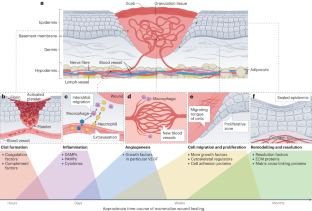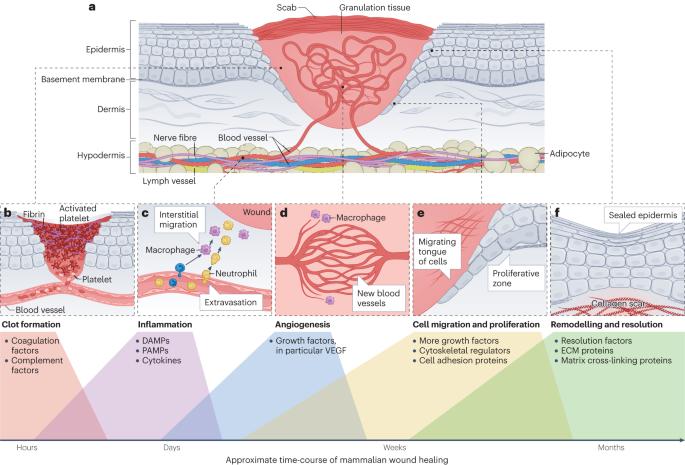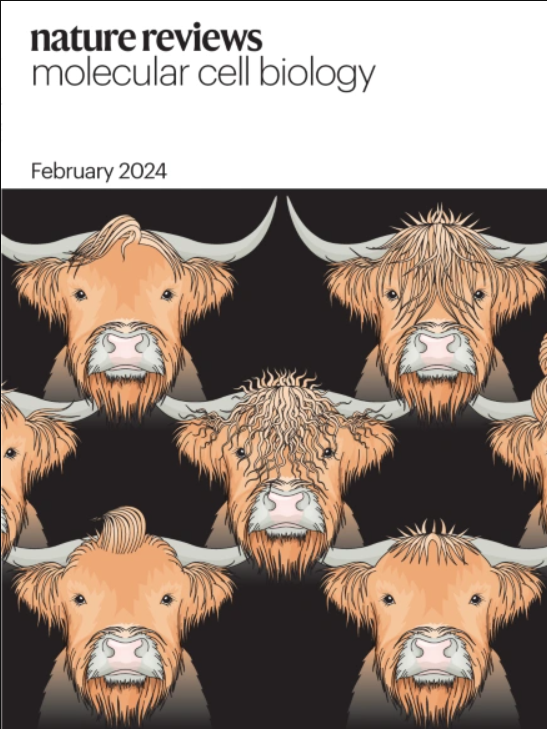皮肤伤口愈合的细胞和分子机制
IF 90.2
1区 生物学
Q1 CELL BIOLOGY
引用次数: 0
摘要
伤口愈合是一个复杂的过程,涉及许多不同组织和细胞系的协调行动。它需要紧密协调细胞迁移、增殖、基质沉积和重塑,以及炎症和血管生成。皮肤上的小伤口几天就能愈合,而创伤、急性病或大手术造成的较大损伤则需要数周才能愈合,一般会留下纤维化疤痕,影响组织功能。要开发预防疤痕形成和成功修复慢性伤口的疗法,就必须更全面地了解驱动伤口愈合的细胞和分子机制。在本综述中,我们将讨论目前对伤口愈合不同阶段的理解,包括从血块形成到再上皮化、血管生成以及随后的疤痕沉积。我们强调了不同类型细胞对皮肤修复的贡献,重点是伤口炎症反应中的先天性免疫细胞和适应性免疫细胞如何影响经典研究的伤口细胞系,包括角质形成细胞、成纤维细胞和内皮细胞,以及一些研究较少的细胞系,如脂肪细胞、黑色素细胞和皮肤神经。最后,我们将讨论有可能进一步加深我们对组织修复机制的理解的新方法和研究方向。本文章由计算机程序翻译,如有差异,请以英文原文为准。


Cellular and molecular mechanisms of skin wound healing
Wound healing is a complex process that involves the coordinated actions of many different tissues and cell lineages. It requires tight orchestration of cell migration, proliferation, matrix deposition and remodelling, alongside inflammation and angiogenesis. Whereas small skin wounds heal in days, larger injuries resulting from trauma, acute illness or major surgery can take several weeks to heal, generally leaving behind a fibrotic scar that can impact tissue function. Development of therapeutics to prevent scarring and successfully repair chronic wounds requires a fuller knowledge of the cellular and molecular mechanisms driving wound healing. In this Review, we discuss the current understanding of the different phases of wound healing, from clot formation through re-epithelialization, angiogenesis and subsequent scar deposition. We highlight the contribution of different cell types to skin repair, with emphasis on how both innate and adaptive immune cells in the wound inflammatory response influence classically studied wound cell lineages, including keratinocytes, fibroblasts and endothelial cells, but also some of the less-studied cell lineages such as adipocytes, melanocytes and cutaneous nerves. Finally, we discuss newer approaches and research directions that have the potential to further our understanding of the mechanisms underpinning tissue repair. This Review discusses the complex mechanisms of wound healing — cell migration, matrix remodelling, inflammation and angiogenesis — and the contributions of different cell types, including immune cells, to this process. It also highlights new methodologies that could inform future therapies to prevent scarring and repair chronic wounds.
求助全文
通过发布文献求助,成功后即可免费获取论文全文。
去求助
来源期刊
CiteScore
173.60
自引率
0.50%
发文量
118
审稿时长
6-12 weeks
期刊介绍:
Nature Reviews Molecular Cell Biology is a prestigious journal that aims to be the primary source of reviews and commentaries for the scientific communities it serves. The journal strives to publish articles that are authoritative, accessible, and enriched with easily understandable figures, tables, and other display items. The goal is to provide an unparalleled service to authors, referees, and readers, and the journal works diligently to maximize the usefulness and impact of each article. Nature Reviews Molecular Cell Biology publishes a variety of article types, including Reviews, Perspectives, Comments, and Research Highlights, all of which are relevant to molecular and cell biologists. The journal's broad scope ensures that the articles it publishes reach the widest possible audience.

 求助内容:
求助内容: 应助结果提醒方式:
应助结果提醒方式:


